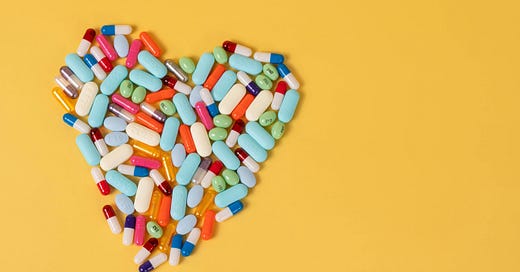Part 2: Investigating Why Fewer Women Take Statins Compared to Men
Even though heart disease is the number one cause of death for males and females, males are prescribed life saving medication more often
Quick Note: When I use the term “woman” in this article, I’m referring to anyone who menstruates, but I acknowledge that not all people who menstruate identify as women and not all people who identify as women menstruate.
Hiya!
In part one of this article, we dove into some history of heart disease, and the discrimination and bias the medical community and American society had about who experiences heart disease. While less severe, gender and sex bias continues into the 21st century, even though heart disease is the number one cause of death for both men and women.
On the plus side, deaths from heart disease have dramatically fallen over the last 30 years (for both sexes), thanks in large part to a group of prescription medications collectively known as statins. Typically a lifelong treatment, statins are proven to be so effective at reducing the risk of cardiovascular diseases that current guidelines recommend statin therapy for all adult patients with coronary heart disease, regardless of sex.
However, researchers discovered that while men and women benefit equally from statins, women are undertreated for cardiovascular problems, less likely to be prescribed statins for high cholesterol, and more likely to discontinue the treatment when they are offered it than men.
Cholesterol and Stains
As you know, plaque build-up in cardiac arteries is a major contributor to heart disease. Plaque forms when fats and cholesterol lodge along the artery wall, narrowing and restricting blood flow to the heart.
While cholesterol is typically referred to as one thing, there are actually two types. Our liver creates one kind, called blood cholesterol, which helps make hormones and digest fatty foods. Then there’s dietary cholesterol, which we consume through animal foods such as eggs, meat, dairy products, poultry, and some kinds of seafood.
Typically, when people talk about lowering their cholesterol, they mean making changes to their diets to limit the high-cholesterol foods they eat. Unfortunately, such an approach doesn’t work for everyone. Brian Cambi, a Yale Medicine cardiologist, explained to Kathy Katella, a senior clinical writer for Yale Medicine, that:
“Genetically speaking, some of us make more cholesterol than others, and some of us have blood vessels that absorb more cholesterol than others.”
This sneaky genetic relationship to cholesterol is why some people who eat a healthy diet and regularly exercise are surprised to learn that they have high cholesterol.
Enter statins.
Medically known as “HMG CoA reductase inhibitors,” statins are a group of medications that reduce blood cholesterol levels by inhibiting the enzymes produced by the liver that help synthesize cholesterol. This helps prevent fatty deposits in the arteries and significantly decreases a person’s risk of stroke or heart attack.
The type and dosage of statin medications vary, but they’re typically a lifelong treatment to prolong their effects. Cambi explains three critical things statins do:
“One, they lower the amount of bad cholesterol in the bloodstream that can be deposited in the arteries.
“Two, almost all of us have some amount of plaques, and statins stabilize the covering [what’s called the fibrous cap] over these plaques, rendering them less likely to rupture, thereby decreasing the chance of an unstable plaque or a heart attack.
“Three, statins put up theoretical ‘roadblocks’ in the vessel wall, helping to prevent cholesterol from being deposited in its lining.”
Beyond cholesterol, statins have anti-inflammatory and antioxidant effects, further reducing the chances of a heart attack or stroke.
The best part about statins is that they’re equally effective at decreasing the risk of coronary events in both men and women and yet, research repeatedly finds that women are less likely to use statins than men.



